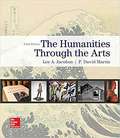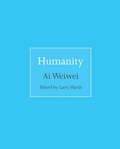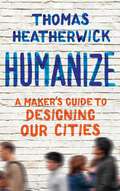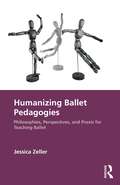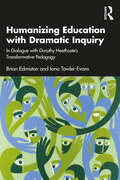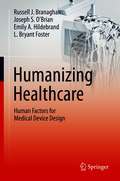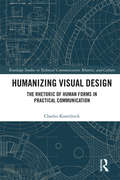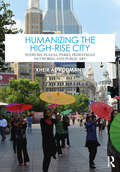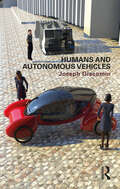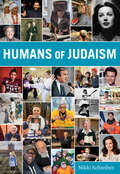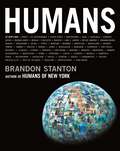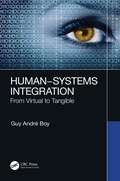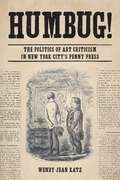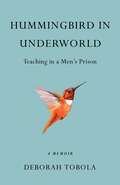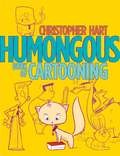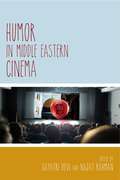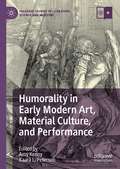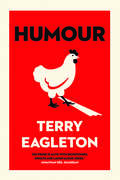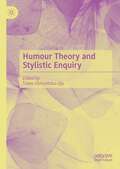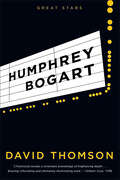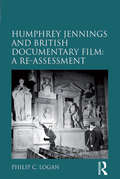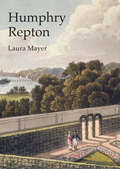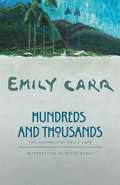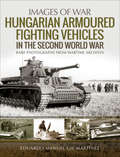- Table View
- List View
Humanities through the Arts
by F. David MartinHumanities Through the Arts tenth edition continues to explore the humanities with an emphasis upon the arts as an expression of cultural and personal values examining the relationship of the humanities to important values objects and events. The book is arranged topically by art form from painting sculpture photography and architecture to literature music theater film and dance. <P><P>Four major pedagogical boxed features enhance student understanding of the genres and of individual works within the genres: Perception Key boxes Conception Key boxes Experiencing boxes and new Focus On boxes. Intended for introductory-level interdisciplinary courses offered across the curriculum in the Humanities Philosophy Art English Music and Education departments this beautifully illustrated text helps students learn how to actively engage a work of art.
Humanity
by Larry Warsh Weiwei AiWritings on human life and the refugee crisis by the most important political artist of our timeAi Weiwei (b. 1957) is widely known as an artist across media: sculpture, installation, photography, performance, and architecture. He is also one of the world's most important artist-activists and a powerful documentary filmmaker. His work and art call attention to attacks on democracy and free speech, abuses of human rights, and human displacement--often on an epic, international scale.This collection of quotations demonstrates the range of Ai Weiwei's thinking on humanity and mass migration, issues that have occupied him for decades. Selected from articles, interviews, and conversations, Ai Weiwei's words speak to the profound urgency of the global refugee crisis, the resilience and vulnerability of the human condition, and the role of art in providing a voice for the voiceless.Select quotations from the book:"This problem has such a long history, a human history. We are all refugees somehow, somewhere, and at some moment.""Allowing borders to determine your thinking is incompatible with the modern era." "Art is about aesthetics, about morals, about our beliefs in humanity. Without that there is simply no art." "I don't care what all people think. My work belongs to the people who have no voice."
Humanize: A Maker's Guide to Designing Our Cities
by Thomas HeatherwickFrom one of the world&’s most innovative designers comes a fiercely passionate manifesto on why so many places have become miserable and boring and how we can make them better for everyone—featuring hundreds of photographs and illustrations that will change how you see the world around you.We are living through a global catastrophe. Buildings affect how we feel, moment by moment, day by day. They have the power to lift us up and make us feel awestruck, playful, safe, and inspired, just as they can make us feel alienated and sad. But many of the places where we live, work, learn, and heal have become monotonous and disposable. We&’re surrounded by cheap, boring buildings that make people stressed, sick, and unhappy. In short, much of our world has been crafted in a way that is hostile to human experience. Now, drawing on his experience of the last thirty years in making bold, beautiful objects and buildings, Thomas Heatherwick offers both an informed critique of the inhumanity in most of today&’s contemporary building design, and a rousing call for action. Looking through Heatherwick&’s eyes, we see familiar landmarks and cityscapes around the world, from London, Paris, Barcelona, Singapore, New York, Vancouver, and beyond, both old and new, famous and obscure, to learn how places can either sap the life out of us—or nourish our senses and our psyche. The time has come, he says, to put emotion back at the heart of the design process, and the reasons to do so could not be more urgent. Design is not superficial: it has an impact upon economics, climate change, our mental and physical wellbeing—even the peace and cohesion of our societies. As citizens and users, we need a world full of architectural diversity that delights and unites us. And as makers and designers, we can help create a world where cities reconnect with their essential mission: to provide human spaces where people mix, meet, inspire each other, and live out their full potential. Elegantly crafted by Heatherwick&’s own studio, and fully illustrated with hundreds of black-and-white photos, Humanize is an urgent call-to-arms for making our world a better place for everyone to live, and provides the vision and tools for us to make it a reality.
Humanizing Ballet Pedagogies: Philosophies, Perspectives, and Praxis for Teaching Ballet
by Jessica ZellerIn Humanizing Ballet Pedagogies, Jessica Zeller offers a new take on the ballet pedagogy manual, examining how and why ballet pedagogies develop, considering their implications for students and teachers, and proposing processes by which readers can enact humanizing, equitable approaches.This book supports pedagogical thinking and development in ballet. Across three parts, it reflects how pedagogies come to be: through rationales, dialogues, and practices. Part 1, Philosophies, offers a contextual reading of ballet pedagogy’s historic relationship to ideals, and it describes an alternative approach that takes its meaningful purpose from the embodied knowledge of participants in the ballet class. Part 2, Perspectives, looks at how the teacher’s person shapes the ballet class. It draws from a new survey of ballet students that illuminates the direct effects of pedagogies and proposes future directions. Praxis, Part 3, includes three theoretically based approaches that can be applied directly or adjusted to readers’ contexts for teaching ballet: yielding to student agency and autonomy, ungrading graded ballet classes in higher education, and practicing reflection for growth. Grounded in the wide range of people who participate in ballet, themes of equity, ethics, and humanity are at the heart of this book.Humanizing Ballet Pedagogies is a valuable resource for those teaching or developing a teaching approach in ballet. It addresses important issues for school owners, administrators, or anyone responsible for supporting ballet teachers or students in the twenty-first century.
Humanizing Education with Dramatic Inquiry: In Dialogue with Dorothy Heathcote’s Transformative Pedagogy
by Brian Edmiston Iona Towler-EvansHumanizing Education with Dramatic Inquiry provides a comprehensive rationale for why and how dramatic inquiry can be used by any teacher to humanize classroom communities and the subject areas being explored with students. Written by teacher educators Brian Edmiston and Iona Towler-Evans, the book re-evaluates the radical humanizing dramatic enquiry pedagogy of British educator Dorothy Heathcote, as developed by the authors in their own teaching using her three approaches: Process Drama, Mantle of the Expert, and the Commission Model. Through scholarly yet practical analysis of extended examples drawn from their own classroom teaching, the volume demonstrates how teachers can collaborate with students of all ages, dispositions, presumed abilities, and cultural backgrounds to transform classroom life into a richly humanizing, curious, inquiring, imaginative community. This book will appeal to educators and teacher educators not only those open to using drama pedagogies in classrooms and in therapy but also to those engaged in applied theatre. Additionally, it will interest those in literacy and education in general who are committed to inclusive, critical, antiracist, anti-oppressive, and artistic practices.
Humanizing Healthcare – Human Factors for Medical Device Design
by Russell J. Branaghan Joseph S. O’Brian Emily A. Hildebrand L. Bryant FosterThis book introduces human factors engineering (HFE) principles, guidelines, and design methods for medical device design. It starts with an overview of physical, perceptual, and cognitive abilities and limitations, and their implications for design. This analysis produces a set of human factors principles that can be applied across many design challenges, which are then applied to guidelines for designing input controls, visual displays, auditory displays (alerts, alarms, warnings), and human-computer interaction. Specific challenges and solutions for various medical device domains, such as robotic surgery, laparoscopic surgery, artificial organs, wearables, continuous glucose monitors and insulin pumps, and reprocessing, are discussed. Human factors research and design methods are provided and integrated into a human factors design lifecycle, and a discussion of regulatory requirements and procedures is provided, including guidance on what human factors activities should be conducted when and how they should be documented.This hands-on professional reference is an essential introduction and resource for students and practitioners in HFE, biomedical engineering, industrial design, graphic design, user-experience design, quality engineering, product management, and regulatory affairs.Teaches readers to design medical devices that are safer, more effective, and less error prone;Explains the role and responsibilities of regulatory agencies in medical device design;Introduces analysis and research methods such as UFMEA, task analysis, heuristic evaluation, and usability testing.
Humanizing Visual Design: The Rhetoric of Human Forms in Practical Communication (Routledge Studies in Technical Communication, Rhetoric, and Culture)
by Charles KostelnickThis book analyzes the role that human forms play in visualizing practical information and in making that information understandable, accessible, inviting, and meaningful to readers—in short, "humanizing" it.Although human figures have long been deployed in practical communication, their uses in this context have received little systematic analysis. Drawing on rhetorical theory, art history, design studies, and historical and contemporary examples, the book explores the many rhetorical purposes that human forms play in functional pictures, including empowering readers, narrating processes, invoking social and cultural identities, fostering pathos appeals, and visualizing data.The book is aimed at scholars, teachers, and practitioners in business, technical, and professional communication as well as an interdisciplinary audience in rhetoric, art and design, journalism, engineering, marketing, science, and history.
Humanizing the High-Rise City: Podiums, Plazas, Parks, Pedestrian Networks, and Public Art
by Kheir Al-KodmanyThe transformative power of urban design in shaping our experiences within high-rise cities takes center stage in Humanizing the High-Rise City: Podiums, Plazas, Parks, Pedestrian Networks, and Public Art. This captivating exploration delves into the art of turning towering skyscraper cities into vibrant havens that foster human connection, celebrate culture, and build communities. Unveiling the secrets behind the creation of urban spaces, from dynamic plazas that encourage social interaction to tranquil parks that infuse life into steel and glass, the book unfolds a narrative that resonates with the innate rhythms of humanity. Examining 20 major high-rise cities worldwide (including Chicago, New York City, Dubai, Shanghai, Hong Kong, and Singapore, among others), synthesizing extensive literature, and enriched with over 200 photographs, this book showcases projects seamlessly weaving nature, art, and connectivity into the urban fabric. These endeavors craft environments that enhance well-being and instill a profound sense of belonging amid the challenges of urban density. As the global landscape increasingly tilts toward vertical living, this book serves as a guiding light, illuminating the path to a heightened and enriched experience of high-rise urban living. This book will be useful to practitioners and students of architecture, urban planning, and urban design interested in improving high-rise cities.
Humans and Autonomous Vehicles
by Joseph GiacominThis book provides an introduction to the Human Centred Design of autonomous vehicles for professionals and students. While rapid progress is being made in the field of autonomous road vehicles the majority of actions and the research address the technical challenges, with little attention to the physical, perceptual, cognitive and emotional needs of humans. This book fills a gap in the knowledge by providing an easily understandable introduction to the needs and desires of people in relation to autonomous vehicles. The book is "human centred design" led, adding an important human perspective to the primarily technology-driven debates about autonomous vehicles. It combines knowledge from fields ranging from linguistics to electrical engineering to provide a holistic, multidisciplinary overview of the issues affecting the interactions between autonomous vehicles and people. It emphasises the constraints and requirements that a human centred perspective necessitates, giving balanced information about the potential conflicts between technical and human factors. The book provides a helpful introduction to the field of design ethics, to enhance the reader’s awareness and understanding of the multiple ethical issues involved in autonomous vehicle design. Written as an accessible guide for design practitioners and students, this will be a key read for those interested in the psychological, sociological and ethical factors involved in automotive design, human centred design, industrial design and technology.
Humans of Judaism
by Nikki SchreiberAn inspirational, visual collection of Jewish stories, curated by the editor and founder of the popular social media brand @humansofjudaism. When her father passed away in 2013, Nikki Schreiber found comfort in her mourning by creating a social media space for sharing positive and uplifting Jewish stories. Thus was born @humansofjudaism, the hugely popular site with over 500,000 followers across all platforms. It is a space for sharing everything—personal stories, Jewish history, Holocaust education, support for Israel, and so much more. Humans of Judaism the book is a highly-visual, inspirational volume of 300 short Jewish stories—a mix of the most popular stories on @HumansofJudaism, as well as new content created just for the book. We meet the founder of Barbie, the founder of Zabar's, actress and model Gal Gadot, and so many others.Humans of Judaism is a celebration of Jewish life and community and a keepsake that Jews all around the world will want to own or gift to one another.
Humans: Stories (Humans Of New York #2)
by Brandon StantonBrandon Stanton’s new book, Humans—his most moving and compelling book to date—shows us the world. <p><p> Brandon Stanton created Humans of New York in 2010. What began as a photographic census of life in New York City, soon evolved into a storytelling phenomenon. A global audience of millions began following HONY daily. Over the next several years, Stanton broadened his lens to include people from across the world. <p> Traveling to more than forty countries, he conducted interviews across continents, borders, and language barriers. Humans is the definitive catalogue of these travels. The faces and locations will vary from page to page, but the stories will feel deeply familiar. Told with candor and intimacy, Humans will resonate with readers across the globe—providing a portrait of our shared experience. <p> <b>A New York Times Bestseller</b>
Human–Systems Integration: From Virtual to Tangible
by Guy André BoyHuman–Systems Integration: From Virtual to Tangible Subject Guide: Ergonomics and Human Factors This book is an attempt to better formalize a systemic approach to human–systems integration (HSI). Good HSI is a matter of maturity… it takes time to mature. It takes time for a human being to become autonomous, and then mature! HSI is a matter of human–machine teaming, where human–machine cooperation and coordination are crucial. We cannot think engineering design without considering people and organizations that go with it. We also cannot think new technology, new organizations, and new jobs without considering change management. More specifically, this book is a follow-up of previous contributions in human-centered design and practice in the development of virtual prototypes that requires progressive operational tangibility toward HSI. The book discusses flexibility in design and operations, tangibility of software-intensive systems, virtual human-centered design, increasingly autonomous complex systems, human factors and ergonomics of sociotechnical systems, systems integration, and changed management in digital organizations. The book will be of interest to industry, academia, those involved with systems engineering, human factors, and the broader public.
Humbug!: The Politics of Art Criticism in New York City's Penny Press
by Wendy Jean KatzApproximately 300 daily and weekly newspapers flourished in New York before the Civil War. A majority of these newspapers, even those that proclaimed independence of party, were motivated by political conviction and often local conflicts. Their editors and writers jockeyed for government office and influence. Political infighting and their related maneuvers dominated the popular press, and these political and economic agendas led in turn to exploitation of art and art exhibitions. Humbug traces the relationships, class animosities, gender biases, and racial projections that drove the terms of art criticism, from the emergence of the penny press to the Civil War.The inexpensive “penny” papers that appeared in the 1830s relied on advertising to survive. Sensational stories, satire, and breaking news were the key to selling papers on the streets. Coverage of local politicians, markets, crime, and personalities, including artists and art exhibitions, became the penny papers’ lifeblood. These cheap papers, though unquestionably part of the period’s expanding capitalist economy, offered socialists, working-class men, bohemians, and utopianists a forum in which they could propose new models for American art and society and tear down existing ones.Arguing that the politics of the antebellum press affected the meaning of American art in ways that have gone unrecognized, Humbug covers the changing politics and rhetoric of this criticism. Author Wendy Katz demonstrates how the penny press’s drive for a more egalitarian society affected the taste and values that shaped art, and how the politics of their art criticism changed under pressure from nativists, abolitionists, and expansionists. Chapters explore James Gordon Bennett’s New York Herald and its attack on aristocratic monopolies on art; the penny press’s attack on the American Art-Union, an influential corporation whose Board purchased artworks from living artists, exhibited them in a free gallery, and then distributed them in an annual five-dollar lottery; exposés of the fraudulent trade in Old Masters works; and the efforts of socialists, freethinkers, and bohemians to reject the authority of the past.
Hummingbird in Underworld: Teaching in a Men's Prison, A Memoir
by Deborah TobolaAt the age of forty-five, Deborah Tobola returns to her birthplace, San Luis Obispo, to work in the very prison her father worked in when he was a student at Cal Poly. But she&’s not wearing a uniform as he did; she&’s there to teach creative writing and manage the prison&’s arts program—a dream job. As she creates a theatre program for prisoners, Tobola finds plenty of drama off the stage as well. Inside the razor wire she finds a world frozen in the &’50s, with no contact with the outside except by telephone; officers who think prisoners don&’t deserve programs; bureaucrats who want to cut arts funding; and inmates who steal, or worse. But she loves engaging prisoners in the arts and helping them discover their voices: men like Opie, the gentleman robber; Razor, the roughneck who subscribes to The New Yorker; charismatic Green Eyes, who really has blue eyes; Doo Wop, a singer known for the desserts he creates from prison fare. Alternating between tales of creating drama in prison and Tobola&’s own story, Hummingbird in Underworld takes readers on an unforgettable literary journey—one that is frank, funny, and fascinating.
Humongous Book of Cartooning (Christopher Hart's Cartooning)
by Christopher HartChris Hart's Humongous Book of Cartooning is a great value book covering everything the beginner needs to master cartooning. It teaches how to draw cartoon people, fantasy characters, layouts, background design and much more. This latest cartoon title from Chris Hart, the world's bestselling author of drawing and cartooning books, packs a wallop. It's the cartooning book that has it all: cartoon people, animals, retro-style "toons'", funny robots (no one has ever done cartoon robots in a how-to book before, and movies like "Wall-E" and "Robots" were smash hits and prove their appeal), fantasy characters and even sections on cartoon costumes, character design, and cartoon backgrounds and composition. The Humongous Book of Cartooning is humongous, not only because it's so big, but also because it includes a huge amount of original eye-catching characters and copious visual "side hints" that Chris is famous for. There is more actual instruction in this book than in any other of Chris' cartooning titles. In short, if you want to know how to draw cartoons, Chris Hart's Humongous Book of Cartooning is for you.From the Trade Paperback edition.
Humor in Middle Eastern Cinema
by Gayatri Devi Najat RahmanWhile Middle Eastern culture does not tend to be associated with laughter and levity in the global imagination, humor--often satirical--has long been a staple of mainstream Arabic film. In Humor in Middle Eastern Cinema, editors Gayatri Devi and Najat Rahman shed light on this tradition, as well as humor and laughter motivated by other intent--including parody, irony, the absurd, burlesque, and dark comedy. Contributors trace the proliferation of humor in contemporary Middle Eastern cinema in the works of individual directors and from the perspectives of genre, national cinemas, and diasporic cinema. Humor in Middle Eastern Cinema explores what humor theorists have identified as an "emancipatory," "liberatory," even "revolutionary" function to humor. Among the questions contributors ask are: How does Middle Eastern cinema and media highlight the stakes and place of humor in art and in life? What is its relation to the political? Can humor in cinematic art be emancipatory? What are its limits for its intervention or transformation? Contributors examine the region's masterful auteurs, such as Abbas Kiarostami, Youssef Chahine, and Elia Suleiman and cover a range of cinematic settings, including Egypt, Iran, Israel, Lebanon, Palestine, Syria, Tunisia, and Turkey. They also trace diasporic issues in the distinctive cinema of India and Pakistan. This insightful collection will introduce readers to a variety of contemporary Middle Eastern cinema that has attracted little critical notice. Scholars of cinema and media studies as well as Middle Eastern cultural history will appreciate this introduction to a complex and fascinating cinema.
Humorality in Early Modern Art, Material Culture, and Performance (Palgrave Studies in Literature, Science and Medicine)
by Kaara L. Peterson Amy KennyHumorality in Early Modern Art, Material Culture, and Performance seeks to address the representation of the humors from non-traditional, abstract, and materialist perspectives, considering the humorality of everyday objects, activities, and performance within the early modern period. To uncover how humoralism shapes textual, material, and aesthetic encounters for contemporary subjects in a broader sense than previous studies have pursued, the project brings together three principal areas of investigation: how the humoral body was evoked and embodied within the space of the early modern stage; how the materiality of an object can be understood as constructed within humoral discourse; and how individuals’ activities and pursuits can connote specific practices informed by humoralism. Across the book, contributors explore how diverse media and cultural practices are informed by humoralism. As a whole, the collection investigates alternative humoralities in order to illuminate both early modern works of art as well as the cultural moments of their production.
Humour
by Terry EagletonA compelling guide to the fundamental place of humour and comedy within Western culture—by one of its greatest exponents Written by an acknowledged master of comedy, this study reflects on the nature of humour and the functions it serves. Why do we laugh? What are we to make of the sheer variety of laughter, from braying and cackling to sniggering and chortling? Is humour subversive, or can it defuse dissent? Can we define wit? Packed with illuminating ideas and a good many excellent jokes, the book critically examines various well-known theories of humour, including the idea that it springs from incongruity and the view that it reflects a mildly sadistic form of superiority to others. Drawing on a wide range of literary and philosophical sources, Terry Eagleton moves from Aristotle and Aquinas to Hobbes, Freud, and Bakhtin, looking in particular at the psychoanalytical mechanisms underlying humour and its social and political evolution over the centuries.
Humour Theory and Stylistic Enquiry
by Taiwo Oloruntoba-OjuThis edited book brings together scholarly chapters on linguistic aspects of humour in literary and non-literary domains and contexts in different parts of the world. Previous scholarly engagements and theoretical postulations on humour and the comic provide veritable resources for reexamining the relationship between linguistic elements and comic sensations on the one hand, and the validity of interpretive humour stylistics on the other hand. Renowned Stylistics scholars, such as Michael Toolan, who writes the volume’s foreword against the backdrop of nearly four decades of scholarly engagement with stylistics, and Katie Wales, who in this volume engages with Charles Dickens, one of the most eminent satirists in English literature, as well as many other European and African authors who have worked ceaselessly in the area of humour and language, weigh in on the topic of language and humour in this volume. Together, they provide a variety of interesting perspectives on the topic, deploying different textual sources from different media and from different regions of the world. Part of the book’s offering includes integrative stylistic approaches to humour in African, European and American written texts, examinations of social media and political humour in Nigeria, Cameroon and Zimbabwe, pragmatics and humorous stance-taking, incongruity as comedy in works of fiction, and a unified levels of linguistic analysis approach to the investigation of humour. This book will be of interest to academics and students of Linguistics, Stylistics, Communications and Media Studies, and Humour Studies. Taiwo Oloruntoba-Oju is a Professor in the Department of English at the University of Ilorin in Nigeria
Humphrey Bogart (Great Stars)
by David Thomson"Look, I'm hardly pretty, he seems to say. I sound like gravel; I look rough and tough; and, honest, I don't give you the soft, foolish answers the pretty boys will give you. You may not like what I say, but you better believe it." He became a legend as "Bogie," the world-weary, wisecracking outsider, but in reality Humphrey Bogart was plagued by doubts and demons. He was born upper-class yet made his name playing mavericks, drank with the Rat Pack, and met four wives on set—including his great love, Lauren Bacall—yet always mistrusted stardom. Here David Thomson, one of film's most provocative writers, reveals the man behind cinema's greatest icon.
Humphrey Jennings and British Documentary Film: A Re-assessment
by Philip C. LoganHumphrey Jennings ranks amongst the greatest film makers of twentieth century Britain. Although a relatively unknown figure to the wider public, his war-time documentaries are regarded by many (including Lord Puttnam, Lindsay Anderson and Mike Leigh) as amongst the finest films of their time. Groundbreaking both in terms of their technique and their interest in, and respect for, the everyday experiences of ordinary people, these films are much more than mere government propaganda. Instead, Jennings work offers an unparalleled window into the British home-front, and the hopes, fears and expectations of a nation fighting for its survival. Yet until now, Jennings has remained a shadowy figure; with his life and work lacking the sustained scholarly investigation and reassessment they deserve. As such film and social historians will welcome this new book which provides an up-to-date and thorough exploration of the relationships between Jennings life, ideas and films. Arguing that Jennings's film output can be viewed as part of a coherent intellectual exercise rather than just one aspect of the artistic interests of a wide ranging intellectual, Philip Logan, paints a much fuller and more convincing picture of the man than has previously been possible. He shows for the first time exactly how Jennings's artistic expression was influenced by the fundamental intellectual, social and cultural changes that shook British society during the first decades of the twentieth century. Combining biography, social history and international artistic thought, the book offers a fascinating insight into Jennings, his work, the wider British documentary film movement and the interaction between art and propaganda. Bringing together assessments of his tragically short life and his films this book is essential reading for anyone with an interest in British cinema or the social history of Britain in the 1930s and 40s.
Humphry Repton
by Laura MayerHumphry Repton (1752-1818) ambitiously styled himself Capability Brown's successor; the century's next great improver of landed property. He believed that the art of laying out grounds could only be achieved by 'the united powers of the landscape painter and the practical gardener', and ingeniously combined his knowledge of farming with a talent for topographical sketching. Over thirty years Repton amassed an incredible four hundred commissions, capitalizing on the whims of the fashion-conscious upper classes left rudderless after Brown's death. Sensitive and snobbish, Repton's ambitions were twofold. He sought to ingratiate himself among the aristocracy, whilst simultaneously raising the status of his adopted profession. Consequently his famous Red Books, illustrated to help clients visualize the potential of their estates, also encouraged an appreciation of landscape aesthetics. This book looks at Repton's theoretic principles and how they underpin his landscape gardening. By detailed site investigations, it traces his approach to landscape design from Picturesque wildernesses like Blaise Castle, Bristol, to the progressive Gardenesque style of Wanstead House in Greater London.
Hundreds and Thousands
by Emily Carr Gerta MorayEmily Carr's journals from 1927 to 1941 portray the happy, productive period when she was able to resume painting after dismal years of raising dogs and renting out rooms to pay the bills. These revealing entries convey her passionate connection with nature, her struggle to find her voice as a writer, and her vision and philosophy as a painter.
Hungarian Armoured Fighting Vehicles in the Second World War (Images of War)
by Eduardo Manuel MartínezThis WWII history vividly captures the Hungarian tanks and military vehicles that fought in Central and Eastern Europe through rare wartime photographs. The Kingdom of Hungary emerged from the Great Depression as a staunch ally of Germany and Italy. In the Second World War, the Central European country not only organized its armed forces in support of the Axis Powers, but also developed its own military industry to supply weapons and equipment to its troops. The Hungarian military produced all kinds of weapons, vehicles and armored vehicles, although they were generally under-gunned and under-armored. This book explores Hungary's participation in the Second World War through superb photographs showcasing its varieties of armored fighting vehicles. Wartime images take the reader from the beginning of the USSR campaign all the way to the bloody Siege of Budapest and the last clashes in Austrian and Slovenian territory before the army's unconditional surrender.
Hungarian Armoured Fighting Vehicles in the Second World War (Images of War)
by Eduardo Manuel MartínezThis WWII history vividly captures the Hungarian tanks and military vehicles that fought in Central and Eastern Europe through rare wartime photographs. The Kingdom of Hungary emerged from the Great Depression as a staunch ally of Germany and Italy. In the Second World War, the Central European country not only organized its armed forces in support of the Axis Powers, but also developed its own military industry to supply weapons and equipment to its troops. The Hungarian military produced all kinds of weapons, vehicles and armored vehicles, although they were generally under-gunned and under-armored. This book explores Hungary's participation in the Second World War through superb photographs showcasing its varieties of armored fighting vehicles. Wartime images take the reader from the beginning of the USSR campaign all the way to the bloody Siege of Budapest and the last clashes in Austrian and Slovenian territory before the army's unconditional surrender.
